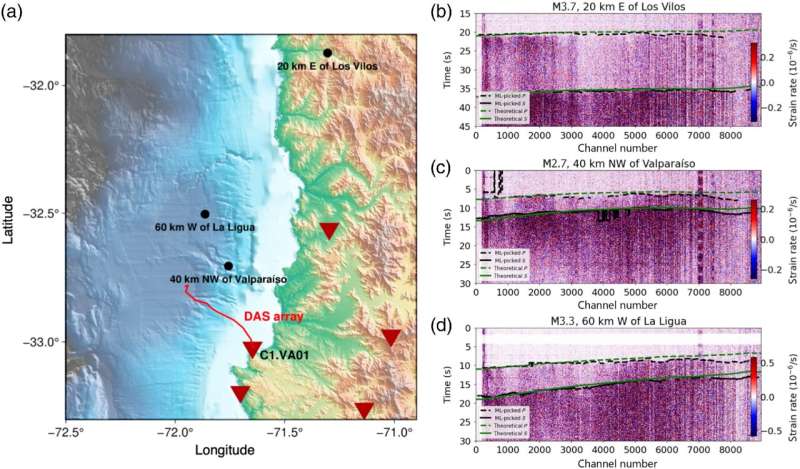This article has been reviewed according to Science X's editorial process and policies. Editors have highlighted the following attributes while ensuring the content's credibility:
fact-checked
trusted source
proofread
Researchers test seafloor fiber optic cable as an earthquake early warning system

One of the biggest challenges for earthquake early warning systems (EEW) is the lack of seismic stations located offshore of heavily populated coastlines, where some of the world's most seismically active regions are located.
In a new study published in The Seismic Record, researchers show how unused telecommunications fiber optic cable can be transformed for offshore EEW.
Jiuxun Yin, a Caltech researcher now at SLB, and colleagues used 50 kilometers of a submarine telecom cable running between the United States and Chile, sampling seismic data at 8,960 channels along the cable for four days. The technique, called Distributed Acoustic Sensing or DAS, uses the tiny internal flaws in a long optical fiber as thousands of seismic sensors.
Yin and colleagues used the cable data to determine earthquake locations and estimate earthquake magnitudes for one onshore (magnitude 3.7) and two offshore (magnitude 2.7 and 3.3) earthquakes during the study period.
Their results show that using this single DAS array offers an approximate three-second improvement in earthquake early warning compared to onshore DAS arrays. In a simulation run by the researchers, they found that by deploying multiple DAS arrays spaced 50 kilometers apart and working together in the area, they could improve EEW alert times in the subduction zone by five seconds.
"While we did expect some improvements due to the offshore placement of the DAS array, the actual speed gains were beyond our initial projections," Yin said. "The key advantage is the array's offshore location, which eliminates the need to wait for seismic waves to reach land-based stations."
The region offshore from Chile is similar to that of the Cascadia region offshore from Canada and the U.S. Pacific Northwest. Both areas contain an active subduction zone, where tectonic plates collide and one plate plunges beneath another, causing some of history's largest and most destructive earthquakes. Even offshore of Southern California, numerous faults have hosted magnitude 6 or larger earthquakes. In all of these densely populated coastal areas, offshore earthquake early warning could help protect lives and property.
"The primary reason for selecting this cable is Chile's elevated seismic risk. The region experiences frequent offshore earthquakes and has been affected by several significant magnitude 8+ earthquakes in history, including the largest ever recorded in 1960," Yin explained. "Given the high seismic risk and potentially devastating impacts of a large earthquake, there's a pressing need for a reliable offshore earthquake early warning system in Chile."
The researchers used a deep learning artificial intelligence model, which is trained and validated on previous seismic and DAS data, to pick out the earthquake waves from the DAS data of this offshore cable. "In the specific case of DAS, the volume of data collected is substantial. For real-time applications like EEW, pre-trained deep learning models provide a highly efficient and reliable option," Yin said. He noted, however, that other traditional seismological methods of picking earthquakes can still be effective in processing DAS data with automation.
Yin said researchers need more data, especially from larger magnitude earthquakes, to develop and test EEW algorithms effectively, as well as more information on how DAS instruments respond before building a real-time EEW system that integrates with existing EEW frameworks.
There are plenty of places around the world to continue this research, he noted.
"There are more than 1,500 cable landing stations around the globe, and the progress in the technology permits the use of operational cables and adding DAS systems without affecting [telecommunications] data transportation." Yin said. "We believe that this opens up a host of exciting research opportunities, and we are keen to explore these in future studies. We are looking for close interactions with cable owners, environmental agencies, and policymakers to scale the DAS-EEW for the benefit of coastal communities."
More information: Jiuxun Yin et al, Real-Data Testing of Distributed Acoustic Sensing for Offshore Earthquake Early Warning, The Seismic Record (2023). DOI: 10.1785/0320230018
Provided by Seismological Society of America




















